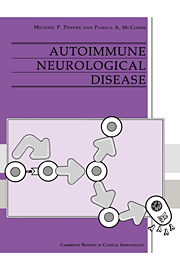Book contents
- Frontmatter
- Contents
- Preface
- 1 Antigen recognition and self–non-self discrimination
- 2 An introduction to neuroimmunology
- 3 Experimental autoimmune encephalomyelitis
- 4 Multiple sclerosis
- 5 Acute disseminated encephalomyelitis
- 6 The stiff-man syndrome
- 7 Experimental autoimmune neuritis
- 8 The Guillain–Barré syndrome and acute dysautonomia
- 9 Chronic immune-mediated neuropathies
- 10 Autoimmune diseases of the neuromuscular junction and other disorders of the motor unit
- 11 Inflammatory myopathies and experimental autoimmune myositis
- 12 Paraneoplastic neurological disorders
- 13 Neurological complications of connective tissue diseases and vasculitis
- Index
3 - Experimental autoimmune encephalomyelitis
Published online by Cambridge University Press: 22 September 2009
- Frontmatter
- Contents
- Preface
- 1 Antigen recognition and self–non-self discrimination
- 2 An introduction to neuroimmunology
- 3 Experimental autoimmune encephalomyelitis
- 4 Multiple sclerosis
- 5 Acute disseminated encephalomyelitis
- 6 The stiff-man syndrome
- 7 Experimental autoimmune neuritis
- 8 The Guillain–Barré syndrome and acute dysautonomia
- 9 Chronic immune-mediated neuropathies
- 10 Autoimmune diseases of the neuromuscular junction and other disorders of the motor unit
- 11 Inflammatory myopathies and experimental autoimmune myositis
- 12 Paraneoplastic neurological disorders
- 13 Neurological complications of connective tissue diseases and vasculitis
- Index
Summary
Introduction
Shortly after the introduction of the anti-rabies vaccine by Pasteur in 1885, there appeared reports of neurological complications in some of the patients vaccinated. The complications developed after a latent period and consisted of weakness and sensory disturbance in the limbs, sphincter dysfunction and cranial nerve involvement. The clinical picture differed from the typical one of rabies. The pathological findings also were different from those of rabies and consisted of perivascular inflammation and demyelination in the central nervous system (CNS) (Bassoe & Grinker, 1930).
Considerable controversy arose as to the cause of these ‘neuroparalytic accidents’, as they were called. Pasteur's vaccination involved a series of subcutaneous injections of suspensions of desiccated spinal cords of rabbits that had been infected with rabies virus. Theories put forward to explain the neuroparalytic accidents included vaccine transmission of attenuated rabies virus (cited by Bassoe & Grinker, 1930) and a toxic effect of a foreign nerve substance (Müller, 1908).
To elucidate the problem, the effect of injections of nervous tissue in experimental animals was studied. In 1898 Centanni reported that rabbits tolerated injections of brain substance poorly; the resulting weakness, emaciation and abscess formation were not due to infection at inoculation but were attributed to toxins produced by the decomposition of the injected material.
- Type
- Chapter
- Information
- Autoimmune Neurological Disease , pp. 26 - 88Publisher: Cambridge University PressPrint publication year: 1995
- 8
- Cited by

